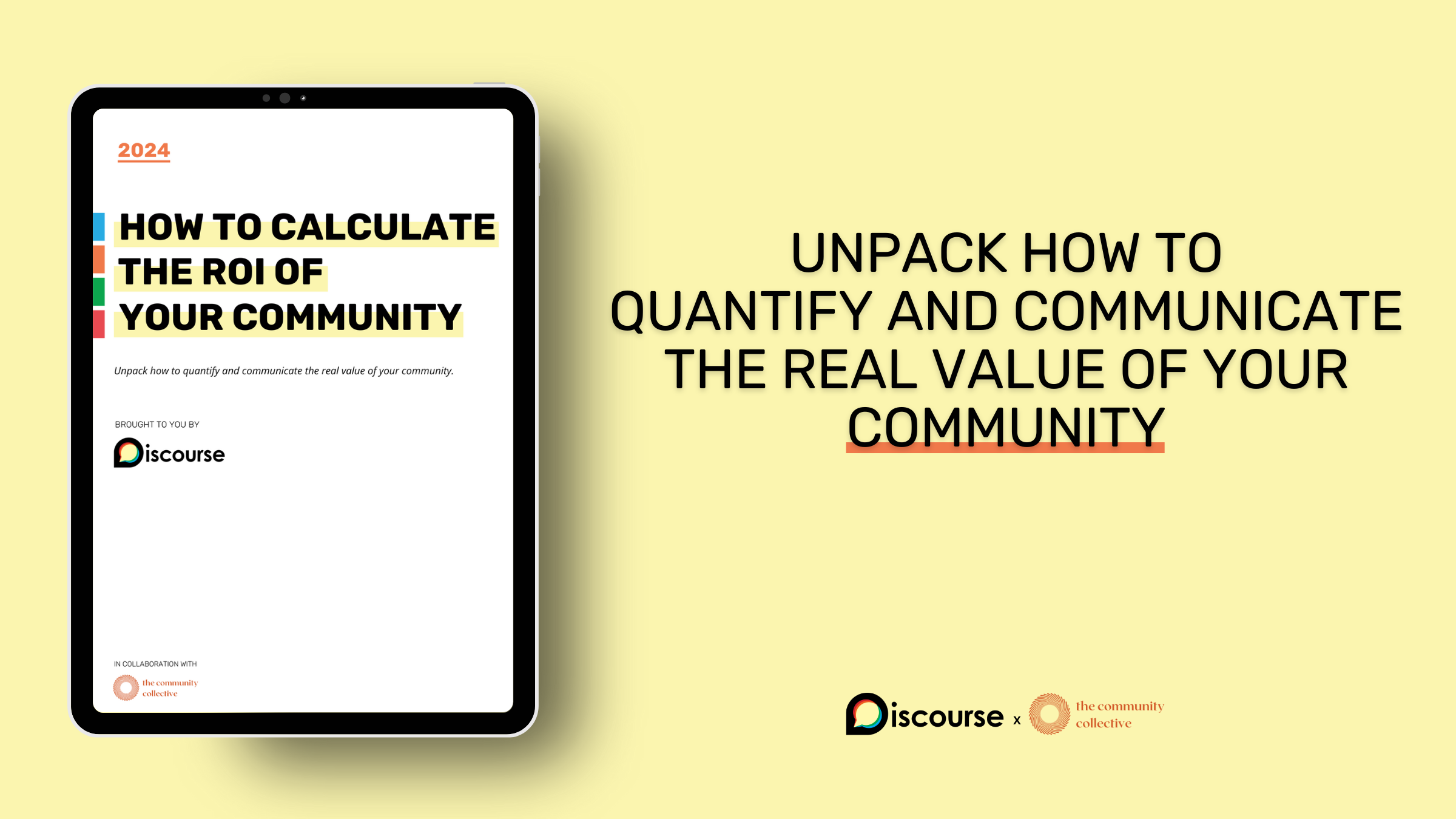20 Community Metrics Explained

Understanding the language of community metrics gives you a leg up when communicating your community’s value to stakeholders. It also helps you identify what’s working, where to improve, and how to make data-driven decisions that strengthen your strategy.
That starts with knowing the right metrics—what they measure, how they reflect engagement, and how they track growth and success. When you understand these metrics in the context of community management, you gain the confidence to build a strategy backed by data and insights. The metrics you choose will always depend on your individual community.
While there are many ways to measure a community, these 20 metrics cover the essentials you need to know.
2. Operational Cost Reduction
3. Support Cost Reduction
4. Customer Acquisition Cost (CAC)
5. Lead Generation
6. Lead Conversion Rate
7. Engagement Rate
8. DAU (Daily Active Users)
9. MAU (Monthly Active Users)
10. Member Acquisition
12. Event Attendance
13. Referral Rate
14. Net Promoter Score (NPS)
15. Disappointment Score
16. Churn Rate
17. Knowledge Base Contributions
18. Community Generated Content
19. Community-Driven Initiatives
20. Product Ideas
1. Return on Investment (ROI)
Refers to the delta between the financial return from the community and the cost of the investment.
Example metric: The community generates a positive ROI of $200k+ per year.
Why it’s useful: ROI allows you to track the effectiveness of your community investment and determine whether your community-building efforts are financially sustainable and profitable.
2. Operational Cost Reduction
Savings due to community efforts, for example from reduced marketing expenses.
Example metric: Community-driven content reduces marketing costs by $15,000 per year.
Why it’s useful: This metric helps measure the financial value of your community in reducing operational costs, showing the direct impact of community engagement on your bottom line. For this metric you will need to interact with the marketing or product departments to find out how much money it is saving them to use the community.
3. Support Cost Reduction
The cost reduction achieved when community members answer questions, deflecting them from paid staff.
Example metric: 25% of all support queries are resolved by community members, saving $5,000 per month in staffing costs.
Why it’s useful: Tracking support cost reduction allows you to gauge the effectiveness of your community as a self-service resource, freeing up resources within your team for other activities.
4. Customer Acquisition Cost (CAC)
The cost of acquiring new customers through the community.
Example metric: Typically the community wouldn’t track the CAC itself but the impact on CAC.
Why it’s useful: Understanding CAC helps you assess how much it costs to gain a customer and whether your community is effectively contributing to lowering that spend.
5. Lead Generation
The number of new leads acquired through the community.
Example metric: 20 new leads are generated through the community per month.
Why it’s useful: Lead generation is key to growing your customer base, and this metric helps measure the community’s effectiveness in attracting new potential clients or customers.
6. Lead Conversion Rate
The percentage of leads that become customers as a result of the community.
Example metric: 25% of new customers are generated from the community per month.
Why it’s useful: By tracking this rate, you can measure how effective your community is in not only generating leads but also converting them into customers, showing the community’s role in driving sales.
7. Engagement Rate
The level of member activity in the community.
Example metric: 20 members are actively engaging with content or discussions each month.
Why it’s useful: This metric indicates the overall health and vibrancy of your community, with higher engagement rates often correlating to stronger community cohesion and better member retention.
8. DAU (Daily Active Users)
The number of members who actively participate in the community on a daily basis.
Example metric: Increase daily active users (DAU) by 20% within the 3rd quarter.
Why it’s useful: DAU tracks real-time insights into how frequently members are interacting with the community, thus a great indicator of value and engagement.
9. MAU (Monthly Active Users)
The number of members who actively participate in the community on a monthly basis.
Example metric: Maintain a MAU of at least 80% of the community per month.
Why it’s useful: MAU provides a broader view of your community's activity levels over time, helping assess long-term engagement and identify trends.
10. Member Acquisition
The number of new members that join in a given time period.
Example metric: 150 new members join the community per month
Why it’s useful: Member acquisition is key to growing your community, and tracking this metric helps you assess whether your growth strategies are effective.
11. Member Stickiness
The level of engagement and connection members have with the community, commonly measured using the DAU/MAU calculations.
Example metric: Maintain a DAU/MAU of at least 20%.
Why it’s useful: A high member stickiness score suggests that your community is attracting members and keeping them active over time.
12. Event Attendance
How many members attend community-hosted events.
Example metric: Maintain an average event attendance of 100+ per event online
Why it’s useful: Event attendance is a good measure of member interest and the effectiveness of your event programming in fostering engagement.
13. Referral Rate
The percentage of members who refer new members or customers.
Example metric: Increase the referral rate of new members by 15% per quarter.
Why it’s useful: A high referral rate indicates that members are satisfied with their experience and willing to advocate for the community, which is essential for sustainable growth.
14. Net Promoter Score (NPS)
How likely members are to recommend the community.
Example metric: NPS stays above 70 each quarter
Why it’s useful: NPS is a valuable metric for assessing overall satisfaction and loyalty, helping you gauge the potential for organic growth and identify areas for improvement and if you expand it to include the product you have a great reason to connect with the Marketing department. It is commonly assessed by the question: “On a scale of 0-10, how likely are you to recommend our community to someone else?”. Find an NPS Calculator here.
15. Disappointment Score
How upset members would be if the community were to disappear, indicating their level of attachment and value.
Example metric: 60% of members say they would be very disappointed if the community ceased to exist per year.
Why it’s useful: This metric helps you gauge the emotional investment and loyalty of your members, which is critical for understanding long-term community sustainability. It is a good alternative to the Net promoter score (NPS).
It is commonly assessed by the question: “On a scale of 0-5, how disappointed would you be if our community no longer existed?”.
16. Churn Rate
The percentage of members who leave the community in a given period.
Example metric: Decrease churn rate by 15% per quarter.
Why it’s useful: Tracking churn helps you identify retention challenges and take proactive steps to keep members engaged.
17. Knowledge Base Contributions
The number of useful contributions made to the community knowledge base, such as articles or resources.
Example metric: 5 new resources added to the community knowledge base by members per month.
Why it’s useful: This shows how members are contributing to the community’s collective knowledge, which can enhance self-service capabilities and foster collaboration.
18. Community Generated Content
The volume of content generated by members.
Example metric: 20 new pieces of content shared on social media is generated by members per month
Why it’s useful: A high volume of community-generated content indicates active engagement, and a sense of ownership among members.
19. Community-Driven Initiatives
The number of initiatives led by community members.
Example metric: 5 community events and workshops are organised and led by community members per quarter.
Why it’s useful: Community-driven initiatives demonstrate a strong sense of ownership and empowerment among members.
20. Product Ideas
Number of new suggestions from members for new features or ideas.
Example metric: 20% of new product features are directly inspired by member feedback and suggestions per month.
Why it’s useful: Member-generated product ideas can lead to more relevant and valuable products or services, increasing customer satisfaction and loyalty. This also tells you how invested members are in shaping the future of your product. You want to make sure you include the Product department in setting targets and expectations.
Final Thoughts
Now that you have a clearer understanding of community metrics, you’re equipped to track what truly matters. The key is to focus on the metrics that align with your goals—whether it’s engagement, retention, growth, or ROI—rather than getting overwhelmed by all the data available.
The real power of these metrics isn’t just in tracking numbers—it’s in using them to tell a story, drive strategy, and communicate impact.
Start by choosing a few key metrics that reflect your community’s goals and use them to make smarter, data-driven decisions. Over time, you’ll develop a stronger sense of what success looks like for your community—and how to achieve it.
Want to Dive Deeper?
Download our free White Paper: How To Calculate the ROI of Your Community, created in collaboration with The Community Collective and top industry experts. This is an essential guide for anyone looking to measure and communicate the real value of their community.

